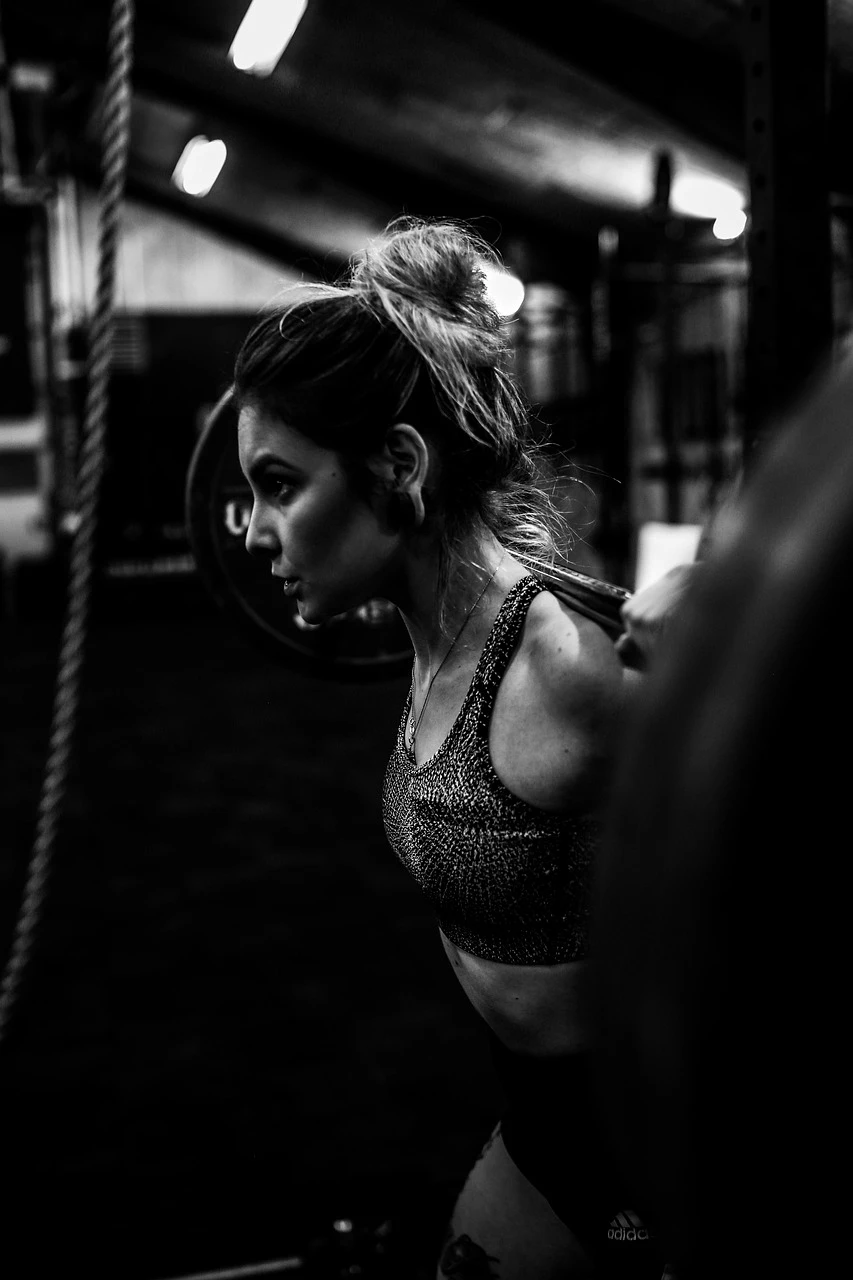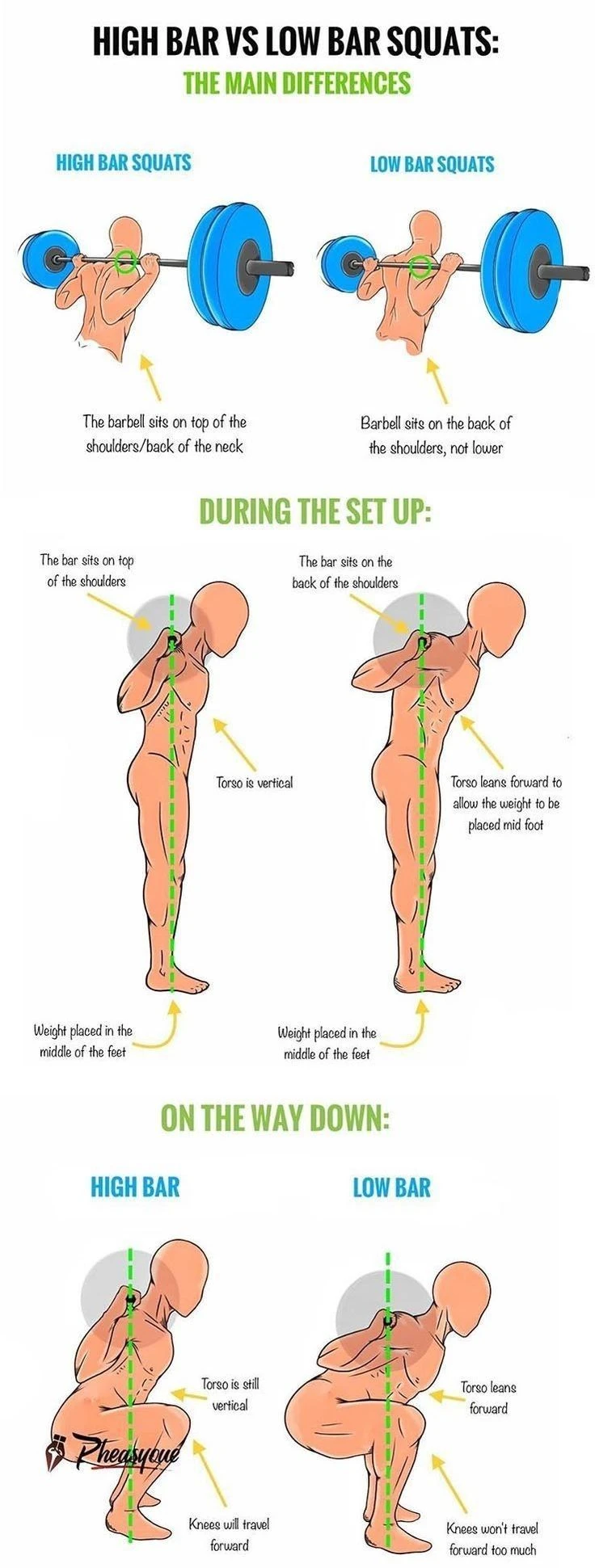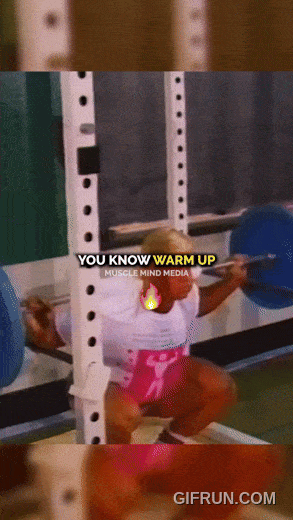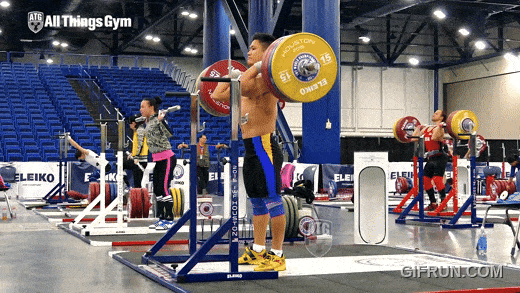"How much can you squat?" It's the most common question in the gym, but it might be the wrong one.
For a powerlifter, a bodybuilder, an Olympic lifter, and a general fitness enthusiast, the numbers behind a squat hide four completely different training philosophies.
Using a bodybuilder's logic to chase a powerlifter's numbers, or a GPP mindset to judge an Olympic lifter's technique, can make your training far less effective.
This article will thoroughly break down the squatting secrets across the four major training systems: GPP, Powerlifting, Bodybuilding, and Olympic Weightlifting, and provide you with a detailed spectrum of squat variations to help you choose the right tool for your goals.
We'll help you find the right "key" for your specific goals, so this "king of all exercises" truly works for you.

The Squat Variant Spectrum: Your Roadmap from General to Specialized
Before we dive into the philosophies, it's crucial to understand the tools at your disposal. The squat is a foundational human movement with a vast "multiverse" of variations, each serving a distinct purpose, from building a broad base to sharpening sport-specific performance.
The Squat for General Physical Preparedness (GPP)
In a GPP program, the goal is to build broad, foundational physical qualities like mobility, stability, and work capacity. Squatting for GPP uses accessible variations to teach proper movement patterns and prepare the body for more intense training.
| Variation | How it Builds GPP | Best For |
|---|---|---|
| Bodyweight Squat | The most basic variation. It reinforces proper form and movement mechanics without external load, serving as the essential starting point for all other squats. | Beginners, warm-ups, or developing fundamental movement competency. |
| Goblet Squat | Holding a kettlebell or dumbbell in front of the chest acts as a counterbalance, helping maintain an upright torso and achieve proper depth. It also increases core engagement. | Teaching proper form, increasing depth, and improving core stability in newer lifters. |
| Box Squat | Squatting to a box or bench provides a tactile cue for depth. Pausing on the box eliminates the stretch reflex, forcing the lifter to recruit more muscle from a dead stop. | Improving technique, correcting depth issues, and emphasizing the posterior chain (glutes and hamstrings). |
| Belt Squat | Using a belt squat machine or a dip belt allows for loaded squatting without axial loading on the spine. It increases leg volume and strength while minimizing spinal stress. | Developing leg drive and volume for lifters with lower back issues or those needing to de-load the spine. |
The Squat as a Specialized Tool
For advanced lifters and athletes, specialized squat variations target specific athletic qualities, address weak points, or replicate sport-specific patterns.
| Variation | How it Specializes | Best For |
|---|---|---|
| Olympic High-Bar Back Squat | The bar is placed high on the traps, with a vertical torso. This emphasizes the quadriceps and ankles, closely mimicking the receiving position in Olympic lifts. | Weightlifters and athletes needing explosive vertical force (e.g., volleyball, basketball). |
| Powerlifting Low-Bar Back Squat | The bar is positioned lower on the back, shifting the torso forward to engage the posterior chain more and allow for heavier loads. | Powerlifters and field sport athletes who need to develop maximal absolute strength. |
| Front Squat | The bar rests on the front shoulders, forcing a vertical torso and challenging the core and upper back. Builds substantial leg strength with less lumbar strain. | Combat athletes, football players, and those building powerful leg drive with less lower back strain. |
| Bulgarian Split Squat | This unilateral (single-leg) exercise improves balance, addresses muscle imbalances, and strengthens legs individually. Has a strong carryover to running and jumping. | Athletes in sports requiring unilateral strength and stability (e.g., racquet sports, track). |
| Jump Squat | A plyometric variation requiring an explosive upward movement. Develops power and engages fast-twitch muscle fibers for increased speed and vertical jump. | Athletes in sports that require explosive movements (e.g., sprinters, basketball players). |
GPP (General Physical Preparedness): The Squat as a Foundation Builder
In the GPP phase, the squat's core mission isn't to chase a max weight.
It's about building a solid movement pattern, improving full-body coordination, and enhancing joint stability, paving the way for more advanced specialization. This philosophy of building well-rounded, durable fitness is the same one that drives popular benchmark workouts like Cindy, one of the most famous CrossFit-style conditioning WODs.
Training Philosophy and Characteristics:
- Moderate Intensity and Volume: Typically using a load of 60-75% of your 1RM for 8-12 reps per set, focusing on quality over quantity.
- Emphasis on Control and Tempo: Intentionally controlling the speed of the eccentric (downward) and concentric (upward) phases, and even adding a pause squat to eliminate the stretch reflex and reinforce stability at the bottom.
- Integrated Training: Squats are often combined with other compound movements like pushes, pulls, and carries in circuits. This approach is designed to improve overall cardiovascular endurance, muscular stamina, and fatigue resistance.
Classic Research and Theory:
- Russian sport scientist Vladimir Zatsiorsky, in his book Science and Practice of Strength Training, emphasizes that GPP is the prerequisite for the success of any specialized training (SPP). A strong GPP foundation prevents injury and allows an athlete to withstand higher training loads in the specialized phase without hitting a plateau early on.
Expert Insights:
- Jim Wendler's 5/3/1 training program is a perfect example of GPP philosophy in action. The plan schedules a large amount of "assistance work" (like jumps, throws, and weighted carries) after the main lifts, aiming to create an athlete who's "not just strong on the platform, but strong everywhere."
Common Mistakes and Fixes:
- Mistake: Knee Valgus (knees caving inward during the squat).
- Reason: Weakness in the glute medius and gluteus minimus, or a lack of ankle dorsiflexion mobility.
Fixes:
- Banded Lateral Walks: Before squatting, use a resistance band around your knees to perform lateral walks. This activates the glute medius.
- Ankle Mobility Drills: Perform stretches like a kneeling ankle stretch to improve range of motion.
- Mental Cue: Consciously think about "tearing the floor apart with your feet" to actively push your knees outward.
Powerlifting: The Squat as the Ultimate Test of Absolute Strength
For powerlifters, the squat’s sole purpose is to lift the biggest single-rep max (1RM) on the competition platform.
Every technical detail and programming strategy is engineered to maximize lifting efficiency.
Training Philosophy and Characteristics:
- Technical Optimization: Powerlifters commonly use a low-bar squat (the barbell rests on the rear deltoids) with a wider stance. This leverages the stronger posterior chain muscles (glutes, hamstrings) and shortens the range of motion, improving leverage.
- Periodized Programming: Training isn't a straight line. It uses a scientific periodization model to wave the training volume and intensity, building strength progressively.
Classic Research and Theory:
- Dr. Mike Zourdos's research on Daily Undulating Periodization (DUP) shows that alternating between high-intensity, low-rep training and moderate-intensity, moderate-rep training within the same week can more effectively stimulate continuous strength gains and prevent neurological plateaus.
Expert Insights:
- Louie Simmons (Westside Barbell) pioneered the Conjugate Method. His system uses a Max Effort Day and a Dynamic Effort Day to constantly challenge the nervous system, allowing athletes to make consistent progress without stagnation. This relentless innovation and competition to be the best is mirrored in the broader functional fitness world, where major events like the CrossFit Games and Rogue Invitational battle for supremacy each year, each pushing the boundaries of what athletes can achieve.
- Ed Coan, arguably the greatest powerlifter of all time, was known for his incredible squat strength and rigorous, high-volume accessory work.
Common Mistakes and Fixes:
- Mistake: Back Rounding (the lower back flexing at the bottom of the squat).
- Reason: Core instability under heavy load or weak hamstrings and lower back muscles.
Fixes:
- Strengthen the Posterior Chain: Incorporate exercises like Romanian Deadlifts (RDLs) and Good Mornings.
- Brace Your Core: Master the Valsalva Maneuver—take a big breath and brace your core, imagining you're "pushing your stomach out into a belt." This creates intra-abdominal pressure to support your spine.

Bodybuilding: The Squat as a Muscle-Building Tool
In bodybuilding, the squat is the king of leg exercises.
Its value isn't measured in pounds, but in the extreme muscle stimulation, metabolic stress, and muscle damage it creates in the quads, glutes, and hamstrings.
Training Philosophy and Characteristics:
- High-Bar Squat: A more upright torso places greater emphasis on the quadriceps.
- Full Range of Motion: Going deep to maximize muscle stretch and increase the time under tension.
- High Volume and Advanced Techniques: Bodybuilders frequently use drop sets, supersets, and rest-pause methods to achieve complete muscular failure.
Classic Research and Theory:
- Dr. Brad Schoenfeld's research highlights the three primary mechanisms of muscle growth: mechanical tension, metabolic stress, and muscle damage. Bodybuilding-style squatting maximizes all three through high volume, full range of motion, and advanced techniques.
Expert Insights:
- Tom Platz, "The Quadfather," was famous for his monstrous quadriceps. His legendary high-rep, heavy-weight squats (like 500 lbs for 23 reps) are a textbook example of creating metabolic stress.
- Jay Cutler, a four-time Mr. Olympia winner, emphasized the "mind-muscle connection" during squats, focusing on the sensation of every contraction and stretch rather than just moving the weight.

Common Mistakes and Fixes:
- Mistake: Inability to hit proper depth.
- Reason: Limited ankle or hip mobility, or a fear of squatting low.
Fixes:
- Improve Mobility: Perform ankle stretches and use weightlifting shoes with a raised heel.
- Box Squats: Place a box or bench behind you to guide your depth and build confidence.
Olympic Weightlifting: The Squat as a Foundation for Explosive Power and Stability
For Olympic lifters, the squat is an assistance lift.
Its value is determined by how well it improves their snatch and clean & jerk.
It directly trains the strength and stability required to receive and stabilize the bar overhead or in the front rack position.
Training Philosophy and Characteristics:
- The Front Squat is Core: It directly mimics the receiving position of the clean and is crucial for developing quad strength and the upper back stability needed to support the bar.
- High-Bar Squat: Its biomechanics are similar to the receiving position of the snatch. It emphasizes speed and depth.
- Overhead Squat: A gold standard for assessing and improving the mobility and stability needed for the snatch.
Classic Research and Theory:
- Coach Greg Everett, in his book Olympic Weightlifting, states, "Your front squat level is the ceiling for your clean & jerk potential." Strong squatting ability allows an athlete to receive a heavier bar lower and with more control.
Expert Insights:
- Dmitry Klokov, a former Russian weightlifting champion, was known for his incredible strength and mobility. His training videos are filled with impressively heavy Front Squats and Overhead Squats.
- Lu Xiaojun, the Chinese weightlifting legend, embodies the high-frequency, high-technique approach to training. Squats are systematically integrated as a way to ensure he has the raw strength to support his lifts.

Common Mistakes and Fixes:
- Mistake: Torso "diving forward" during the clean and jerk reception.
- Reason: Weak upper back (traps, rhomboids) or a lack of core rigidity.
Fixes:
- Strengthen the Upper Back: Do plenty of rows and face pulls.
- Pause Front Squats: At the bottom, pause for 2-3 seconds to build stability in the receiving position.
Your Next Step: An Action Plan
Now that you understand the four training philosophies and the spectrum of variations, it’s time to find your path.
How to apply these insights and choose your tools:
If your goal is to build a foundation and improve overall fitness (GPP):
- Choose Variations: Start with the Goblet Squat or Box Squat, focusing on quality.
- Try a GPP Workout: After your regular squats (5 sets of 10 at 70% 1RM), do a circuit: Farmer's Carry (60 seconds) + Kettlebell Swings (15 reps) + Push-ups (to failure). Rest 90 seconds and repeat 3 times. For more creative, high-energy workouts designed around specific holidays and themes, be sure to check out our Epic Holiday WOD Guide to keep your training fun and challenging all year round.
If your goal is to get as strong as possible (Powerlifting):
- Choose Variations: Master the Low-Bar Back Squat as your primary lift. The Box Squat is also an excellent accessory.
- Plan Your Progression: Don’t just max out every week. Follow a simple 4-week linear plan: Week 1 (4x8), Week 2 (5x5), Week 3 (6x3), Week 4 (test your 1RM or do a heavy 3x2).
If your goal is to build bigger muscles (Bodybuilding):
- Choose Variations: The High-Bar Back Squat, Front Squat, and Bulgarian Split Squat are perfect for adding leg mass.
- Try an Advanced Technique: Add a drop set. Once you reach failure with your working weight, immediately reduce the weight by 20-30% and continue to failure.
If your goal is to boost athletic performance (Olympic Weightlifting):
- Choose Variations: The Front Squat and High-Bar Back Squat are core. Use Jump Squats for power and Bulgarian Split Squats for unilateral strength and imbalance correction.
- Practice Overhead Squats: Use an empty bar or very light weight for overhead squats during your warm-up to improve shoulder, hip, and ankle mobility.
Remember, the best plan is one you can stick to. Start with one small change, be consistent, and you’ll achieve the results you’re after.
Summary: The Squat Multiverse at a Glance
The following table provides a concise overview of how the squat is approached across the four major training systems, now including a "Recommended Variations" column as a quick-reference guide for selecting your tools.
Use this as a quick-reference guide to align your training with your primary goals.
| Training System | Primary Goal | Technical Focus | Typical Programming | Key Metric | Recommended Variations |
|---|---|---|---|---|---|
| GPP | Build foundational movement patterns, overall stamina, & resilience. | Full range of motion, controlled tempo, upright torso. | Moderate volume (e.g., 3-4 sets of 8-12 reps), often integrated into circuits. | Movement Quality & Work Capacity | Goblet Squat, Box Squat, Belt Squat |
| Powerlifting | Maximize 1-Rep Max (1RM) strength for competition. | Low-bar position, wider stance to leverage posterior chain. | Periodized (e.g., Linear, DUP), Conjugate Method (Max Effort + Dynamic Effort days). | Lifted Weight (1RM) | Low-Bar Back Squat, Box Squat |
| Bodybuilding | Maximize muscle hypertrophy (size) in quads, glutes, hamstrings. | High-bar position, full depth to maximize stretch under tension. | High volume, moderate intensity (e.g., 3-5 sets of 8-15 reps), advanced techniques (drop sets, supersets). | Muscle Stimulation & Pump | High-Bar Back Squat, Front Squat, Bulgarian Split Squat |
| Olympic Weightlifting | Develop explosive power & stability for the Snatch & Clean & Jerk. | Front Squat is paramount. Also high-bar and overhead squat for mobility. | High frequency, often paired with technical lifts. Focus on speed and recovery. | Lift Performance & Stability | Front Squat, Overhead Squat, High-Bar Back Squat |
How to Use This Table
- Identify Your Goal: Find the row that best matches your primary objective (e.g., getting stronger, building muscle).
- Adopt the Technique and Tool: Note the "Technical Focus" and "Recommended Variations" for that system.
- Apply the Principles: Use the "Typical Programming" column to guide your set/rep schemes and training methods.
This table simplifies the core philosophies and tools, but the true depth lies in the details explored throughout this article. Revisit the respective sections for the expert insights, research, and drills that make each system effective.
FAQs:Frequently Asked Questions
I want to build a bigger chest. Should I even bother with squats?
Absolutely. While squats are famous for building powerful legs and glutes, they are a true full-body cornerstone. They massively engage your core, back, and stabilizer muscles, leading to better posture, rock-solid stability, and a surge in hormone production that can help all your muscles grow. This holistic strength and metabolic boost are exactly why they're non-negotiable in GPP training.
I feel stuck whenever I try to squat deep. What's holding me back?
The most common culprits are ankle mobility and hip mobility. Don't force it! Improve your range safely by practicing ankle stretches and pausing in the bottom of a bodyweight squat. As discussed in our GPP and Bodybuilding sections, Box Squats are a fantastic tool to teach your body the movement pattern with confidence and guarantee you hit depth every time.
High-bar or low-bar squat—what's the real difference, and which is for me?
It's all about leveraging your anatomy for your goals.
High-Bar (on your traps): Places more stress on the quads. It's the standard for Olympic weightlifting and bodybuilding.
Low-Bar (on your rear delts): Allows you to involve more of your powerful posterior chain (glutes, hamstrings, back), often letting you lift more weight. It's the favorite in powerlifting.
Your choice should align with your primary goal, which we break down in detail in our Powerlifting and Bodybuilding sections.
What's the key difference in programming squats for size vs. strength?
Think of it as Strength = Neural Efficiency vs. Size = Metabolic Stress.
For Strength (Powerlifting): The focus is on lifting heavy weights (>85% 1RM) for low reps (1-5), using methods like periodization and the Conjugate Method to train your nervous system to recruit more muscle fibers.
For Size (Bodybuilding): The goal is to fatigue the muscle with moderate weights (67-85% 1RM) for higher reps (8-12), using techniques like drop sets and supersets to flood the muscle with metabolites and spur growth.
I'm new to this. How do I start squatting without getting hurt or overwhelmed?
Welcome! The best advice is to prioritize technique over weight. Begin with bodyweight squats or just the barbell. Record yourself from the side and check for proper form: chest up, knees tracking over toes, and reaching a depth where your hips drop below your knees. Our GPP section is your best starting point—it's designed to build a bulletproof foundation and correct common mistakes before they become bad habits.


